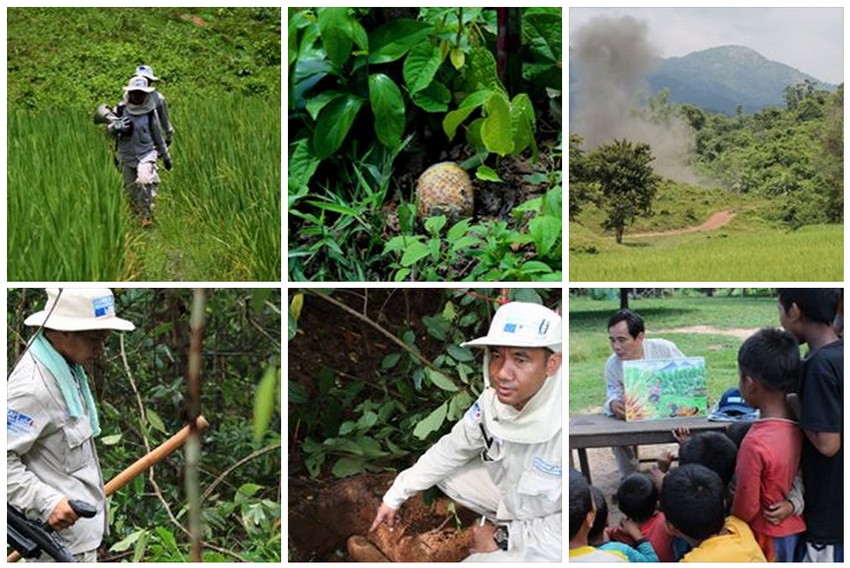The deminers have a solid breakfast, in true Lao tradition: they serve themselves with a fistful of sticky rice from the casserole. A solid ball of rice is kneaded by hand and will be soaked later in hot pepper to be eaten with a little bamboo and chicken. The engines are started up and each of the two teams here in the camp will go its way. Their mission: work towards a safer Laos.
The first mine clearing team takes care of rapid responses intended to destroy the explosive devices found on the surface of the land. Today, they’ll be in the field. The farmer spotted five devices there. The procedure will be the same for all of them: position an explosive charge, pull a cable to about 200 metres away, connect it to a detonator, sound out a warning to everyone… and press the red button. The explosion is impressive every time and makes the heart beat faster. A cloud of smoke rises majestically from the ground. And it’s done. Only a small hole in the ground and some shrapnel are evidence of the danger that was lurking in the mud a moment ago.
Comprising two sections of mine clearers, the second team takes charge of systematic clearance. It focuses on the zones identified as priorities because these are going to be used for development projects. In fact, it is impossible to picture new fields, roads, schools etc. on a ground infested with the unexploded remains of war. The mine clearers are now focusing on a 7,827m² area in the forest. Two-thirds is now safe. Another 50 m² will be reclaimed from terror.
The mine clearers take their places. They are methodically organised. Respecting the procedures guarantees safety in the face of the danger of habit: marking out the work areas, briefing, testing the materials, etc. Every mine clearer moves forward in his or her designated area. The noise of the detectors is continuous and sounds like the cicadas of Provence. But there’s no question here of not paying attention. If a detector emits any other sound, it must be checked: is it just a piece of metal or has it detected cluster munitions?
A map is used to follow the progress of the team. Every bomb is identified here. Little by little, the pattern left by the dropped bomb is drawn. Its trail is clear and anticipates the areas where new cluster munitions will again be discovered.
Soon, six of the residents of the Soppa village will be able to work here to establish a banana plantation so they can work their way out of the extreme poverty that has hit the region. That’s one of the best rewards for the mine clearers.

© D. Kremer / Handicap International
A bewildering calculation
Five little balls in a field. These are cluster munitions, little bombs scattered from mother bombs. These five cluster munitions are of three different models. There were therefore at least three bombs dropped here. How many cluster munitions in all? More than 400 of the BLU 63 and BLU 26 models, and some 200 of the BLU 3b model. The field and surrounding areas were thus ‘sprayed’ by at least 1,000 cluster munitions. The average failure rate of bombings in Laos was 26 %. There are therefore probably some 260 unexploded cluster munitions on the surface or a few centimetres below. 260 cluster munitions in the earth here where the farmer is using a hoe, where the cattle are labouring and where the children take the animals to graze.






